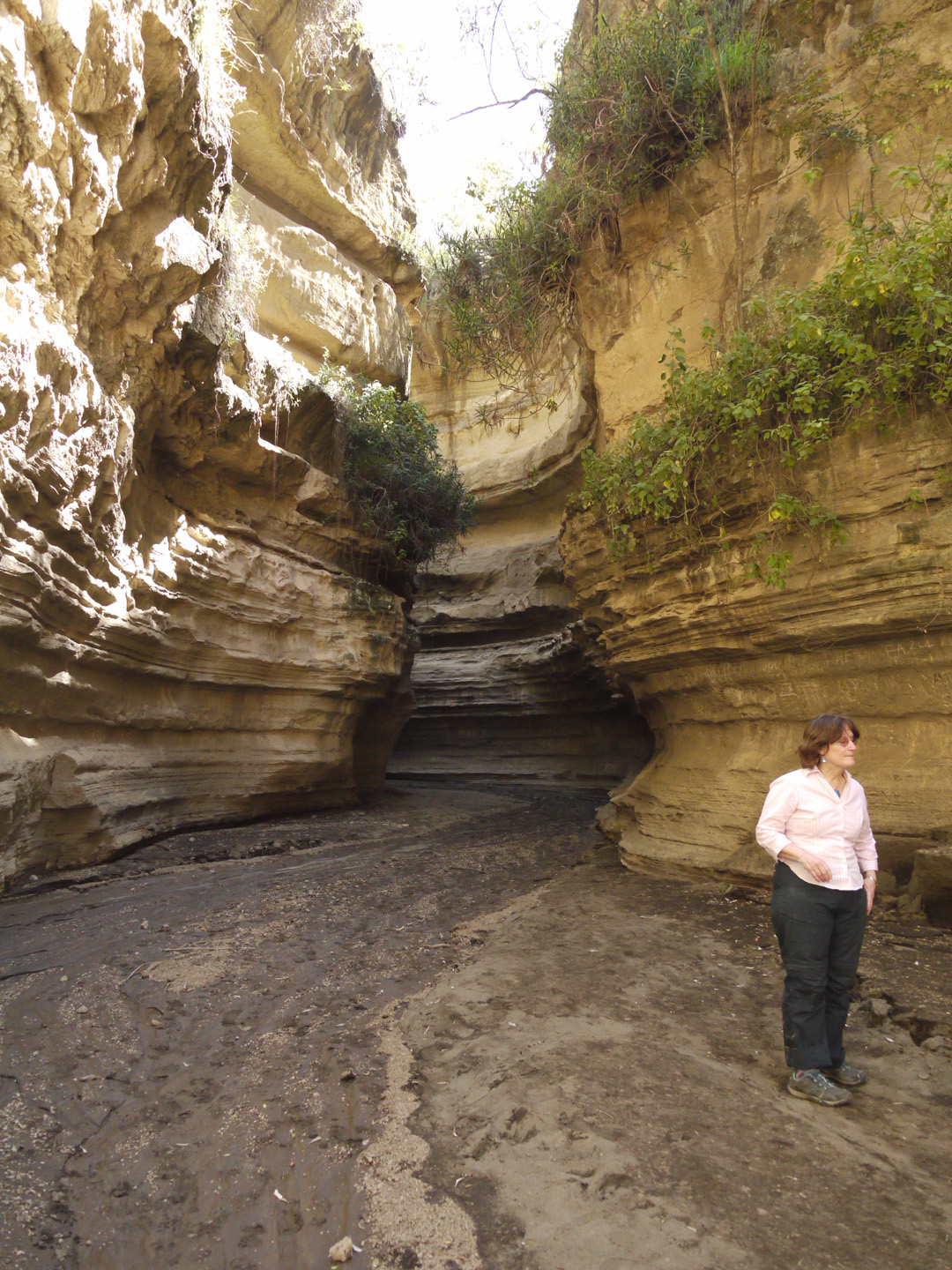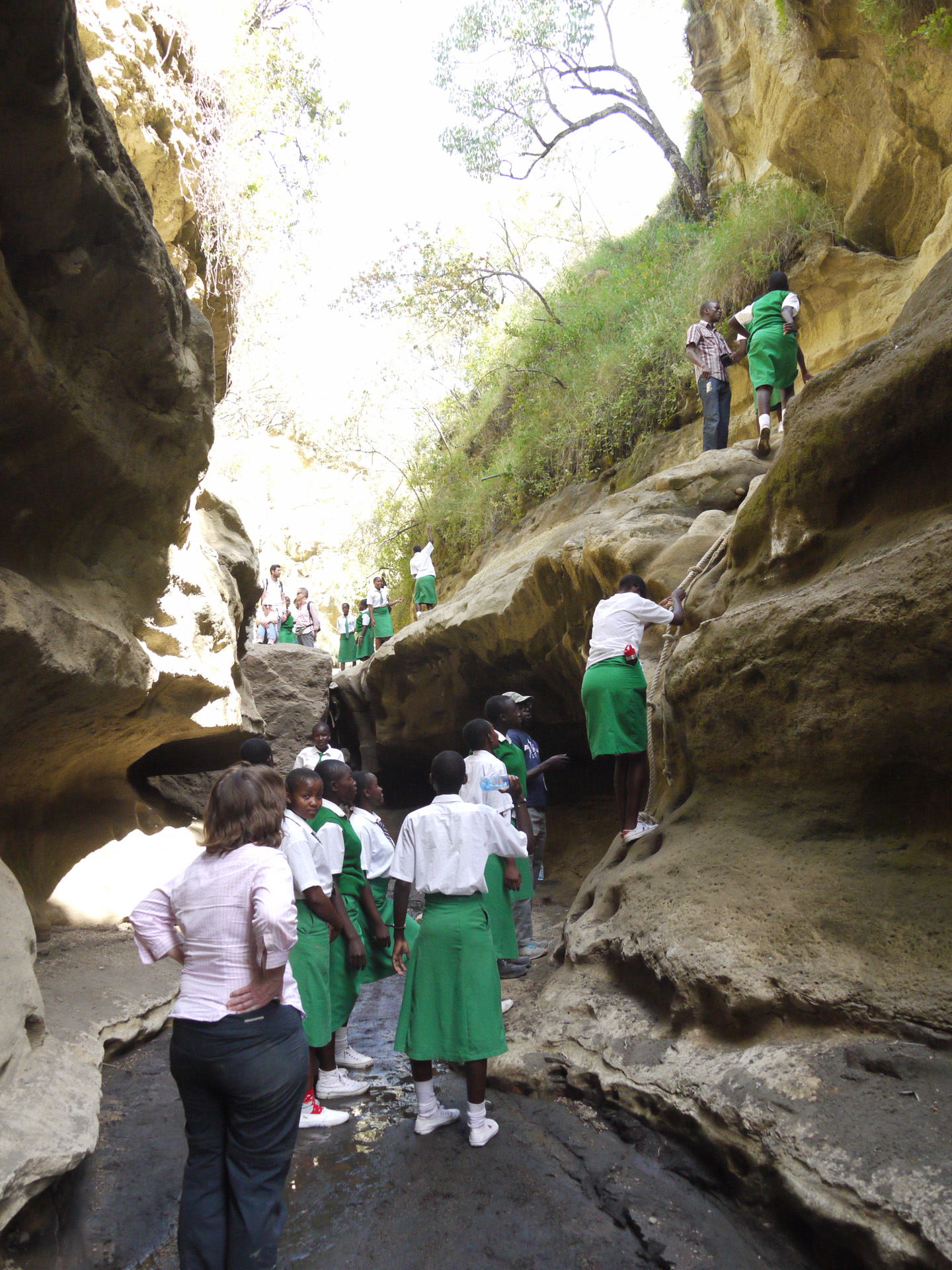Nuns and priests – Limuru – Rift Valley – Railway & old road alongside – Lake Naivasha: Sanctuary Farm & Hells Gate – Nakuru: Millimani Hotel and Planet Fries.
It’s certainly a novel experience to wake up in a convent. I opened our bedroom door to black-suited priests, with bibles clasped in both hands over portly bellies, parading to a meeting. Starched white cuffs and dog collar provided a studied dignity. They returned my greeting with nods worthy of the Pope. The dining room is set out like a canteen and most people have finished breakfast – it is only 7:30 so I guess convents get up early. On a nearby table, a priest is holding forth to four attentive men about creating presence at a baptism. It is a Roman Catholic convent so I should not be surprised that the physical work is being done by headscarved young women in long skirts wearing smiles in their eyes. It was these ladies who ensured that we and the men were fed and watered, that tables were laid, the phones answered, the floors cleaned and swept.
We set off at 9:30 past St John’s Parklands, one of the oldest churches in Nairobi now, where Fred Chater Jack and Emilie May were married on 1st March 1924. Our journey today is to the Rift Valley, Naivasha and Nakuru – the same route Fred and Emilie took often travelling from Kitale to the Muthaiga Club.
 On the way we pass Limuru where the couple had their honeymoon. The diary entry mentions bungalows, gardens, a fresh breeze but no name. It may well be Brackenhurst, a religious retreat and conference centre, which was a hotel with bungalows with gardens in the 1920’s. Today modern large meeting halls replace the bungalows and the wind carries more than a whiff of exhaust.
On the way we pass Limuru where the couple had their honeymoon. The diary entry mentions bungalows, gardens, a fresh breeze but no name. It may well be Brackenhurst, a religious retreat and conference centre, which was a hotel with bungalows with gardens in the 1920’s. Today modern large meeting halls replace the bungalows and the wind carries more than a whiff of exhaust.
The road goes down into the Rift Valley on a gentle incline. The single track one metre gauge railway from Mombasa to Lake Victoria, built between 1899 and 1903 at a cost of £5,317,000, goes down with us. It will remain our faithful companion for most of our trip to Kitale. Until 2012 an up train and a down train ran everyday plus some freight trains. Today the descent into the Rift Valley is a shallow incline and no obstacle, but it took ingenuity to lay the rail tracks from May 1900 – November 1901. An incline lift was required to lower wagons and material into the valley and then a temporary road from the foot of the lift to the point of the permanent line. The lift consisted of four portions with a drum at the top of each, round which a steel rope was passed. The railway wagons were run up and down these – full wagons down hauling up empty ones.
We part with KSH 500/- (£3.00) to enter The Sanctuary Farm on Lake Naivasha – an exclusive hotel run by a long time settler family offering horseback riding among zebra, giraffe and wildebeest. There were many takers. It’s not the Serengeti, but it’s quite pretty. Water Hyacinth is strangling the swampy ground on either side of the road onto Crescent Island, but we baulk at paying $30 each just to walk for half an hour among zebra within a former polo pitch – the same entrance fee for nearby Hell’s Gate National Park. It’s the only way to see Lake Naivasha though as expensive hotels vie with Rose growing enterprises and there is no public land at all.
The National Park runs east/west along the course of a wadi – a dry river bed that becomes a torrent after rain. At that time it cut deep into the earth leaving basalt stacks standing proud in the landscape. In 1882, Gustav Fischer and a surveying party came here mapping a route from Mombasa to Lake Victoria and Uganda. They were slaughtered by Maasai. The 25 metres high basalt Fischer Tower at the National Park entrance is his memorial.
Warthogs and piglets, usually three piglets, are out in large number, their tails upright and stiff as they run. The piglets being comical miniature copies of mum. Impala in large herds graze alongside Plains Zebra, Wildebeest and Rothschild Giraffe. Large lumps of obsidian, a black vitreous rock that resembles bottle glass and forms in volcanic rocks, jut out of the crumbling yellowy country rock. It’s sharp. I can see why it was used as a cutting tool like Flint.
The lower gorge is filled with a gaggle of schoolchildren from Eldoret dressed in green skirts, white shirts – and amazingly in this heat, some are in dark green sleeveless jumpers. It’s about 10 – 15 metres wide of rocky slipperiness and a comforting trickle of water. The sides rise above our heads with many steep emergency exits. It was not hard to imagine the danger if there was rain. I’m sure I would become as a gazelle if I needed to flee this spot.
‘We’re trained to hear the water coming. There are over 100 emergency exits. In 1992, four students were caught and died here because they didn’t have a guide.’ Says Francis Ooloowente, our 23 yr old Maasai guide. Many generations of his clan live here, maybe his ancestors had come across Fischer that day. The Maasai have adapted to modern times. Francis is Christian, will have only one wife and doesn’t value wealth in numbers of cows. He’s studying mechanical engineering at the nearby university in order to work for the local thermal energy company. University fees are KSH 80,000/- (£600) per year, a huge amount for his family, so he is guiding to help with the cost.
The gorge opens onto a confluence with another wadi – the Devil’s Bedroom. It’s wide here, about 40 metres wide. The flow of the hectic current traced in the swoosh of sand riven in the outer curl and rising 15 meters up the high wall as both rivers fight their way down against the flow of the rival water. Over the years, the turbulence has eaten 30 meters into the earth.
 We walk up The Devil’s Bedroom, narrow, high sided, with deep crumbling black silt on the inner bend “Quick sand,” says Francis. This would not be a good place to be caught. The high-sided cliffs, ten to fifteen metres above, lean towards each other leaving about one metre of sky. High above us, ledges afford viewing positions of the river in spate and time for graffiti on each level with dates. The river must be a dramatic sight. I know where I would like to be to experience the drama. After 300 – 400 metres the gorge ends in a high rise of rock and opens out. There must be a wonderful waterfall to see – if you were the right side of it. The school children use ropes to haul themselves up and out of the gorge, they’re doing the long walk. Thankfully we chose the short walk!
We walk up The Devil’s Bedroom, narrow, high sided, with deep crumbling black silt on the inner bend “Quick sand,” says Francis. This would not be a good place to be caught. The high-sided cliffs, ten to fifteen metres above, lean towards each other leaving about one metre of sky. High above us, ledges afford viewing positions of the river in spate and time for graffiti on each level with dates. The river must be a dramatic sight. I know where I would like to be to experience the drama. After 300 – 400 metres the gorge ends in a high rise of rock and opens out. There must be a wonderful waterfall to see – if you were the right side of it. The school children use ropes to haul themselves up and out of the gorge, they’re doing the long walk. Thankfully we chose the short walk!
 The thermals are down the main gorge – four outlets of hot water with one close to boiling point. ‘We used to boil eggs in the mouth of that spring,” Francis points to a small bush laden with whitish fruit that birds do not eat either. “This is Ol-Morijej, the poison arrow tree. We mash the root and dip it onto our arrows when hunting. Once we catch an animal we quickly slit its throat and drain its blood. Then we make a deep wide cut round the place the arrow went in.”
The thermals are down the main gorge – four outlets of hot water with one close to boiling point. ‘We used to boil eggs in the mouth of that spring,” Francis points to a small bush laden with whitish fruit that birds do not eat either. “This is Ol-Morijej, the poison arrow tree. We mash the root and dip it onto our arrows when hunting. Once we catch an animal we quickly slit its throat and drain its blood. Then we make a deep wide cut round the place the arrow went in.”
The sandstone scramble path out of the gorge is crumbly underfoot and the drop steep and rocky. Well anchored rope give confidence, but the path has eroded away from its endpoint requiring clambering without the illusion of a safety net. At the top it’s about a mile walk back to the car and ranger point. We pass many bushes used for medicinal purposes, I write the description and Francis writes in the Maasai name. Stomach aches and indigestion relief seem to be the major preoccupations: Ol-Tubelei, Sodom Apple, a medicinal plant for stomach aches. Ol-Moloij, Terpenith tree – terpentine for stomach upsets. Ol-Kiloriti, Acacia Arabica, for digestion problems.
“This bush,” says Francis scrumpling sage green leaves with a light green underside between his fingers, “is our perfume. We use it after we have killed a goat to make our hands smell sweet and as an underarm deodorant.” The smell is pleasant, fresh and tangy.
We stopped by a Whistling Acacia, heavy with thorns. “This is Ol-Kineloluai, the ants make their home in these black galls and bite the nose of giraffes who eat the leaves.”
We arrive back at the car and drive back through the wide plain of the upper gorge and onto the congested road to Nakuru. In the cool of the late afternoon baboons and warthogs have spilled out of the National Park and are on the verges ignoring the bicycles and buses going by.
We finish the day at a Formica table in Planet Fries, Nakuru, a friendly local restaurant offering fish, beef or chicken cooked BBQ, Maryland or wet – wet means cooked in gravy. I think we’ll take our chances at the hotel tomorrow night.
